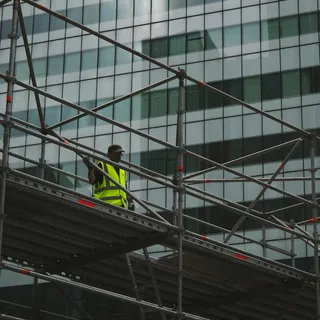When it comes to construction, renovation, or maintenance projects, scaffolding is essential for providing workers with safe access to elevated areas. However, working with scaffolding also comes with risks, and proper safety practices are critical to prevent accidents and injuries. Whether you’re a seasoned professional or new to using scaffolding, it’s crucial to follow safety guidelines to protect yourself and others on the job site. In this article, we’ll discuss five essential safety tips for working with scaffolding.
1. Perform a Thorough Inspection Before Use
Before any work begins, it’s vital to inspect the scaffolding structure carefully. Every component, from the base plates to the guardrails, should be checked to ensure it’s in good condition. Look for signs of wear, corrosion, or damage that could compromise the safety of the structure. Ensure all scaffolding parts are correctly assembled, and that the scaffolding is level and stable. Pay close attention to:
• Footings: Ensure the ground beneath the scaffolding is solid, level, and capable of supporting the load.
• Guardrails and Planks: Confirm that all guardrails, midrails, and toe boards are secure, and that planks are firmly in place.
• Locking Mechanisms: For rolling scaffolds, make sure the wheels are locked when the scaffold is in use, and check that all pins and braces are properly fastened.
Regular inspections should also take place throughout the project, especially if the scaffolding is moved or exposed to adverse weather conditions.
2. Ensure Proper Weight Limits Are Followed
Every scaffolding structure is designed to support a specific maximum load, which includes both the weight of the workers and the materials being used. Exceeding the weight capacity of scaffolding can cause it to collapse, leading to serious accidents. To avoid this, always:
• Know the load limit of your scaffolding system. This information is typically provided by the manufacturer or rental company.
• Distribute weight evenly across the platforms to prevent tipping or shifting.
• Avoid storing excess materials or equipment on the scaffolding to minimize the risk of overloading.
By adhering to the weight restrictions, you’ll help ensure that the scaffolding remains stable and secure throughout the project.
3. Use Personal Protective Equipment (PPE)
Personal protective equipment (PPE) is a critical component of scaffolding safety. Wearing the right gear can significantly reduce the risk of injury in the event of an accident. Some essential PPE for working on scaffolding includes:
• Hard Hats: These protect against head injuries from falling objects or debris.
• Non-Slip Footwear: Proper footwear provides traction on scaffolding platforms, reducing the risk of slips and falls.
• Fall Protection Gear: In some cases, you may need to wear a safety harness, especially when working at heights. Ensure the harness is securely attached to an anchor point at all times.
• Gloves and Eye Protection: Gloves can prevent cuts and abrasions, while safety glasses protect your eyes from dust, debris, or chemicals.
Always ensure your PPE is in good condition and properly fitted to provide the maximum level of protection.
4. Follow Safe Climbing Practices
One of the most common causes of scaffolding-related accidents is improper climbing techniques. Workers should never attempt to climb the scaffolding’s cross braces or use makeshift ladders to reach higher levels. Instead, follow these best practices:
• Use a Ladder or Stair Tower: Always use a ladder or stairway designed for safe access to the scaffolding platform. Ensure that the ladder is securely fastened and provides stable footing.
• Keep Hands Free: When climbing, avoid carrying tools or materials. Instead, use a hoist or pulley system to raise materials to the desired height.
• Maintain Three Points of Contact: When ascending or descending, always maintain three points of contact (two hands and one foot, or two feet and one hand) to ensure stability.
Proper climbing techniques reduce the risk of losing your balance or falling from the scaffolding structure.
5. Be Aware of Environmental Hazards
Working with scaffolding outdoors introduces additional risks, especially in environments prone to high winds, rain, or extreme temperatures. Environmental factors can affect the stability of scaffolding and the safety of workers, so it’s important to:
• Monitor Weather Conditions: Strong winds, heavy rain, or snow can make scaffolding platforms slippery and increase the risk of falls. If weather conditions worsen, it’s often best to pause work and resume only when it’s safe to do so.
• Secure the Scaffolding: In areas with high winds, ensure the scaffolding is securely tied to the building or supported by additional bracing to prevent movement.
• Be Cautious of Power Lines: If the scaffolding is near power lines, maintain a safe distance to avoid electrocution. Always check local regulations to determine the minimum safe clearance required.
By being mindful of environmental hazards, you can take proactive steps to ensure that both the scaffolding and the worksite remain safe.
Conclusion
Scaffolding is an invaluable tool in many construction and renovation projects, but it requires careful attention to safety to prevent accidents. By conducting thorough inspections, adhering to weight limits, using the appropriate PPE, practicing safe climbing techniques, and staying aware of environmental hazards, you can minimize the risks associated with working at height.
We’re committed to providing safe, reliable scaffolding solutions for all types of projects. Whether you need guidance on the right scaffolding system or advice on scaffolding safety, our team of experts is here to help. Contact us today to learn more about how we can support your next project!
This article provides general safety tips for working with scaffolding. Always follow local regulations and industry standards, and consult a professional for specific safety requirements on your job site.

